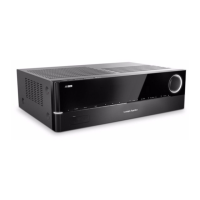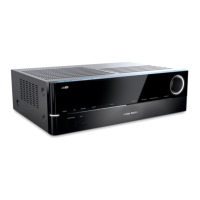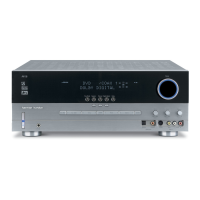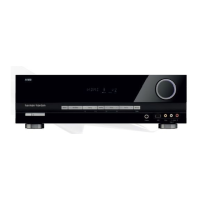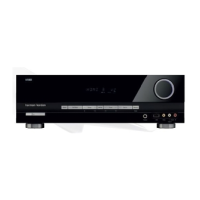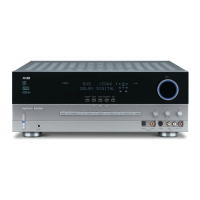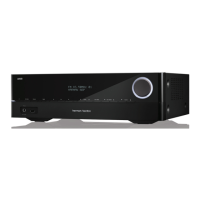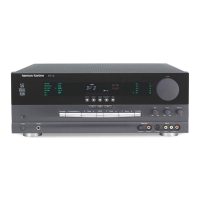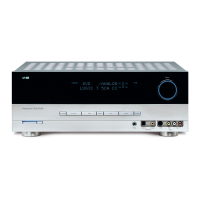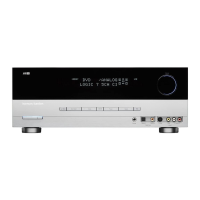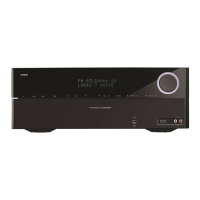
Do you have a question about the Harman Kardon AVR 1700 and is the answer not in the manual?
| Receiver type | - |
|---|---|
| Frequency range | 10 - 100000 Hz |
| Output impedance | 75 Ω |
| Audio output channels | - channels |
| Power output per channel (1KHz@8 Ohm) | 100 W |
| Power output per channel (20-20KHz@8 Ohm) | 95 W |
| HDMI in | 6 |
| Number of HDMI outputs | 1 |
| Ethernet LAN | No |
| FM band range | 87.5 - 108 MHz |
| Supported radio bands | FM |
| 3D | Yes |
| Analog signal format system | NTSC |
| Product color | Black |
| Audio decoders | Dolby Pro Logic, Dolby Pro Logic II, Dolby TrueHD, DTS-HD Master Audio |
| Volume control | Rotary |
| Depth | 350 mm |
|---|---|
| Width | 440 mm |
| Height | 165 mm |
| Weight | 5800 g |
Lists items included with the AVR.
Covers voltage, extension cords, cabinet opening, grounding.
Instructions on proper placement for ventilation and stability.
Describes the power status indicator and button.
Button to adjust channel volume levels.
Receives infrared commands from the remote control.
Used to select highlighted menu items.
Shows current source and surround mode.
Select specific surround sound modes.
Selects the active audio/video source.
Controls the audio volume level.
Toggles tuning modes or RDS functions for radio.
Changes the audio input for the current source.
Navigates menus and makes selections.
Navigates menus or tunes radio stations.
Selects surround-sound categories.
Connects headphones or the setup microphone.
Plays media from USB/iPod devices and for firmware updates.
Connects auxiliary analog audio sources.
Explains the different power states and their indicators.
Action to take if the PROTECT message appears.
Toggles manual/automatic tuning and stereo/mono modes.
Activates RDS functions for FM radio.
Activates channel-level adjustment using Up/Down buttons.
Changes the audio input for the current source using Left/Right buttons.
Receives commands from the remote control.
Selects highlighted menu items.
Navigates AVR menus.
Shows messages for commands and signal changes.
Navigates menus or tunes radio stations.
Selects surround-mode categories like Auto, Virtual, Movie.
Selects specific surround modes within a category.
Selects the active source device.
Connects headphones or the EzSet/EQ microphone.
Plays media from USB/iPod devices and for firmware updates.
Controls the audio volume level.
Connects auxiliary analog audio sources.
Connects to a home network for internet radio and DLNA.
Inputs for digital audio and video signals.
Outputs video and audio to a TV or display.
Inputs for coaxial or optical digital audio signals.
For connecting external control hardware.
Connects AM and FM antennas for radio reception.
Connects analog audio source devices and recorders.
Connects external IR receivers and triggers other devices.
Connects to a powered subwoofer.
Connects loudspeakers to the AVR.
Inputs for composite analog video signals.
Outputs composite analog video to a TV or display.
Turns the AVR's power supply on or off.
Connects the supplied AC power cord.
Turns the AVR or controlled devices on and off.
Mutes the AVR's speaker-output connectors and headphone jack.
Switches the remote to AVR control mode.
Selects source devices and switches remote control mode.
Activates the test tone for channel volume calibration.
Adjusts individual channel-level settings.
Navigates menus or tunes radio stations.
Adjusts the audio volume level.
Accesses bass and treble controls.
Adjusts A/V Sync and speaker delay settings.
Returns to the previous menu screen.
Activates the on-screen display menu system.
Accesses options when controlling other components.
Selects items from the menu system.
Activates the sleep timer.
Navigates the menu system.
Enters numbers for frequencies or presets.
Prepares for direct entry of radio station frequencies.
Saves current radio station as a preset.
Tunes radio stations.
Toggles between manual and automatic tuning modes.
Cycles through preset radio stations.
Activates Night mode for compressed audio.
Skips to the next disc with compatible changers.
Activates RDS functions for FM radio.
Programmed to execute sequences of commands.
Changes tracks or chapters on source components.
Dims the AVR's front-panel display.
Controls playback functions of source components.
Explains controlling AVR and other devices via remote.
Emits infrared codes from the remote.
Lights up to indicate remote programming procedures.
Turns the AVR or device on and off.
Mutes AVR speaker output and headphone jack.
Switches the remote to AVR control mode.
Selects source devices and switches remote control mode.
Activates test tone for channel volume calibration.
Adjusts individual channel-level settings.
Navigates menus or tunes radio stations.
Adjusts the audio volume level.
Accesses bass and treble controls.
Adjusts A/V Sync and speaker delay settings.
Returns to the previous menu screen.
Accesses options when controlling other components.
Activates the on-screen display menu system.
Selects items from the menu system.
Activates the sleep timer.
Navigates the menu system.
Enters numbers for frequencies or presets.
Prepares for direct entry of radio station frequencies.
Clears entered radio station frequency.
Saves current radio station as a preset.
Toggles between manual and automatic tuning modes.
Tunes radio stations.
Cycles through preset radio stations.
Activates Night mode for compressed audio.
Skips to the next disc with compatible changers.
Activates RDS functions for FM radio.
Programmed to execute sequences of commands.
Changes tracks or chapters on source components.
Dims the AVR's front-panel display.
Controls playback functions of source components.
Describes the main components of a home theater setup.
Explains surround sound and speaker types (Front L/R, Center, Surround L/R, Subwoofer).
Discusses different theories and algorithms for surround sound.
Illustrates speaker placement for 5.1 systems and general positioning.
Details positioning for front and center speakers relative to the display.
Details positioning for surround left and right speakers.
Provides guidance and tips for optimal subwoofer placement.
Standard color coding for audio/video connections.
How to connect the subwoofer via RCA cable.
Connecting speakers using two-conductor wire and binding posts.
General information on connecting various source devices.
Using HDMI for digital audio and video signals.
Connecting coaxial digital audio outputs.
Connecting optical digital audio outputs.
Using stereo audio cables for analog connections.
Playing media from USB/iPod and firmware updates.
Making video connections for source devices.
Automatic video connection via HDMI.
Using composite video cables for analog connections.
Connecting FM and AM antennas.
Connecting speakers to the AVR's terminals.
Connecting the AVR to a TV via HDMI or composite video.
Connecting the AVR's subwoofer pre-out to a powered subwoofer.
Connecting various source devices like DVD, Cable, etc.
Connecting devices with HDMI for optimal audio/video.
Connecting devices with optical digital outputs.
Connecting devices with coaxial digital outputs.
Connecting devices with composite video connectors.
Making analog audio connections from source devices.
Connecting analog audio recorders to Rec Out connectors.
Connecting video recorders to Composite Monitor Out.
Connecting AM and FM antennas for optimal reception.
Connecting external IR receivers for cabinet installations.
Connecting to devices controlled by a DC trigger signal.
Connecting the AVR to a home network via Ethernet.
Connecting the AVR's AC power cord to an outlet.
Installing batteries and programming the remote.
Pairing the remote with various source components.
Steps to turn on the AVR using the power switch and button.
Using the EzSet/EQ microphone for automatic speaker calibration.
Navigating menus using the OSD and remote control.
Selecting speaker setup (e.g., 5.1) and running the test.
Assigning audio/video inputs to source selector buttons.
Configuring network settings for Internet radio and DLNA.
Adjusting volume via front panel or remote.
Muting and unmuting the AVR's sound output.
Connecting and using headphones for private listening.
Choosing an audio/video source using front panel or remote.
Solutions for no picture issues.
Steps for resolving HDMI connection problems.
Renaming source device display names.
Activating or deactivating tone controls (bass/treble).
Adjusting bass and treble frequencies.
Compressing loud passages for clearer dialogue.
Setting the source for analog audio recording outputs.
Tuning stations, using preset stations, and tuning modes.
Accessing and playing internet radio streams.
Playing audio from Apple devices via USB port.
Playing MP3 and WMA files from a USB drive.
Steps for playing music files from a USB drive.
Setting up media sharing from PCs using Windows Media Player.
Accessing shared media from network devices.
Playing MP3/WMA files stored on a PC/Mac on the network.
Wirelessly streaming audio from Apple devices via AirPlay.
Choosing surround modes via OSD or front panel buttons.
Explains how audio signals and surround modes affect sound quality.
Discusses Stereo, 5-Ch Stereo, and analog surround modes.
Benefits of digital signals and discrete channel transmission.
How surround mode selection depends on signal format and user taste.
Adjusting Center Width, Dimension, and Panorama for music.
Manually configuring speaker settings if EzSet/EQ is not used.
Setting crossover frequencies for speakers and subwoofer.
Measuring and entering speaker distances for accurate timing.
Adjusting individual speaker levels using test tones or source material.
Using auto or manual test tones for speaker level adjustment.
Resetting all channel levels to factory defaults.
Tips for setting speaker volumes for optimal sound.
Tips for setting subwoofer volume for music and movies.
Customizing AVR features via the System Setup menu.
Adjusting the front-panel display fade time.
Setting the AVR's default volume upon power-on.
Controlling HDMI audio signal passthrough to the TV.
Setting the duration for semi-OSD status messages.
Setting the duration for full OSD menus.
Enabling control information communication between HDMI devices.
Resynchronizing audio and video signals to fix lip-sync issues.
Instructions for installing software upgrades.
Programming unused source selector buttons.
Operating one component while controlling another's functions.
Programming macros for single-button command sequences.
Connecting recorders and making recordings.
Setting the sleep timer to turn off the AVR automatically.
Resetting the remote control to its factory defaults.
Resetting the AVR's processor to factory settings.
Explains how settings are retained during power loss.
Solutions for the AVR not powering on.
Solutions for no audio or video output.
Solutions for amplifier protection mode activation.
Solutions for specific speaker channel audio issues.
Solutions for remote control unresponsiveness.
Solutions for tuner interference and buzzing.
Solutions for programming mode activation issues.
Power output, sensitivity, SNR, frequency response details.
Television formats, input/output levels, HDMI specs.
Power requirements, consumption, dimensions, weight.
FM tuner frequency range, sensitivity, distortion, selectivity.
AM tuner frequency range, sensitivity, distortion, selectivity.
Default connections for various device types.
Default speaker and channel settings.
Worksheet for speaker distance settings.
Worksheet for source-specific settings.
Worksheet for speaker and channel configuration.
Worksheet for remote control product codes.
Worksheet for system settings.
Descriptions and incoming signals for various surround modes.
Descriptions and incoming signals for various surround modes.
Numbered diagram of remote control buttons.
Lists functions of each remote button for various devices.
Lists functions of each remote button for various devices.
Product codes for programming the remote with TVs.
Product codes for programming the remote with TVs.
Product codes for programming the remote with TVs.
Product codes for programming the remote with TVs.
Product codes for programming the remote with TVs.
Product codes for programming the remote with TVs.
Product codes for programming the remote with DVDs.
Product codes for programming the remote with SAT receivers.
Product codes for programming the remote with SAT receivers.
Product codes for programming the remote with SAT receivers.
Product codes for programming the remote with cable boxes.
Product codes for programming the remote with cable boxes.
Product codes for programming the remote with game consoles.
Product codes for programming the remote with music servers.
Product codes for programming the remote with music servers.
Product codes for programming the remote with DVRs.
Product codes for programming the remote with TiVo devices.


